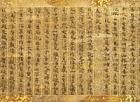Japanese Gallery (Honkan) Room T1
June 14, 2005 (Tue) - July 24, 2005 (Sun)
Hand-copied sutras were used to transmit the teachings of Buddha to later generations. Because of this, the teachings of Buddha remain today. According to one document, Buddhism was officially introduced to Japan in 538; while another document says it was in 552. However, both agree that the introduction was accompanied by sutras. Reflecting the spread of Chinese characters as a writing system, the writing of the Asuka-Nara periods (593 - 794) is crisp. Consequently, the basis of the Japanese calligraphy developed through the process of hand-copying sutras.
During the Heian period (794 - 1192), the writing style continued to develop, gradually becoming softer and smoother. During the middle Heian, emperors and nobles placed a high degree of importance on the Lotus sutra due to the idea of mappo - a belief in the predetermined decline and revival of Buddhism. Because it is mentioned in the Lotus sutra, in order to ensure their rebirth in the pure land, they learned and memorized the Lotus sutra, chanted verses, and commissioned copied sutras. Creating a glorious backdrop for the creation of grand Buddhist temples and exquisite scrolls.
Following the Heian period, with the deep belief that copying the sutras would offer the soul salvation, massive works, such as the Great Wisdom sutra or the complete works of Buddhist scripture, were copied in great quantities.

